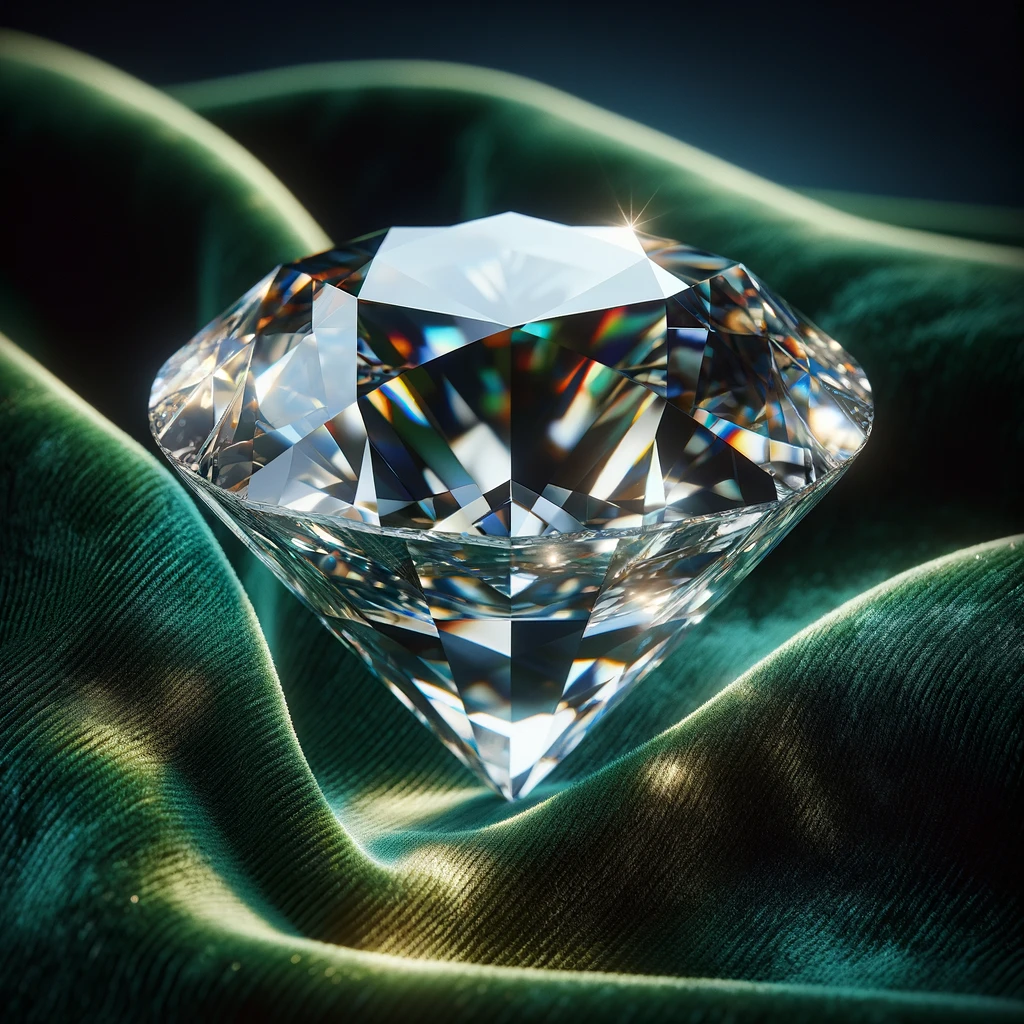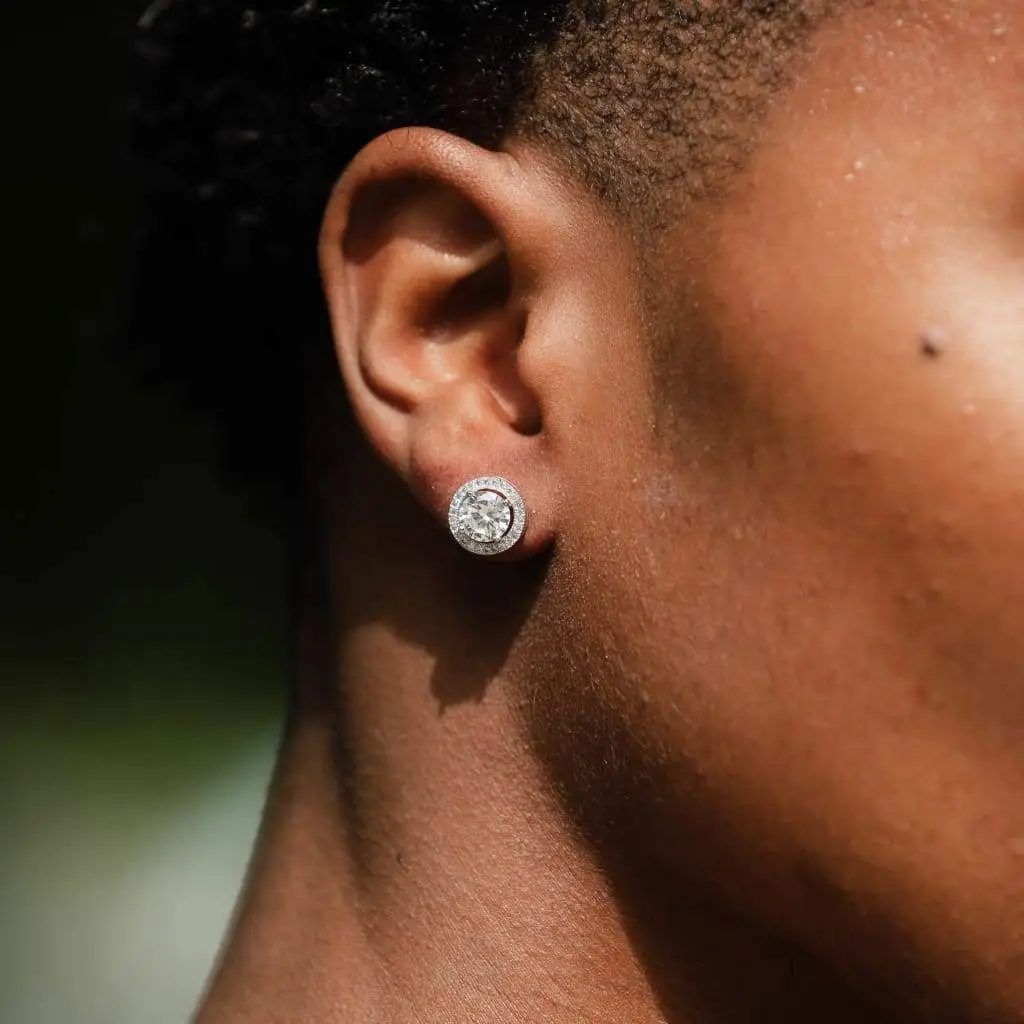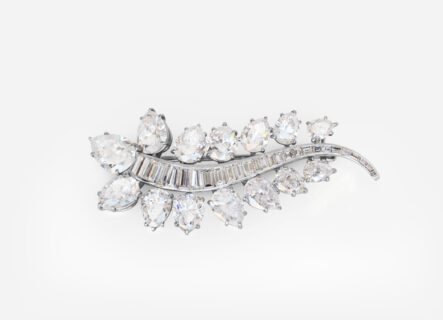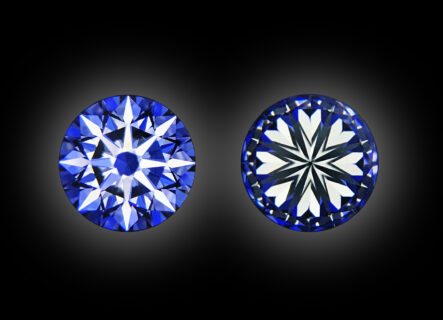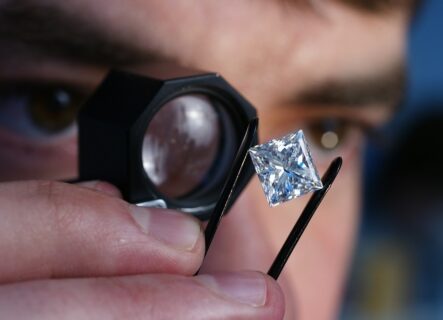Jewelry, mirroring contemporary tastes and global fashion trends, has become gender neutral. While diamond earrings on a man were once seen as a symbol of protest or eccentricity, they are now a commonplace aspect of life that contribute to a polished image and style. Most male celebrities sport diamond jewelry, including diamond stud earrings.
This article offers guidance on purchasing men’s earrings, covering important considerations, potential issues, and other useful information.


The most popular diamond colors
White diamonds are unsurprisingly the most popular choice for diamond earrings worn by men. However, black diamonds are becoming increasingly popular as well for this type of jewelry. Clearly, white diamonds have a timeless, classic appeal, while black stones convey a more mysterious, masculine, and bold aesthetic.
Nevertheless, there are many diamond colors to choose from beyond just white and black. Luckily, diamonds come in a broad spectrum of hues – ranging from pink to blue, yellow to green. Listen to your own preferences and select the diamond shade you like best. Your diamonds can be classic white, which will complement any outfit, or unique pink, which will add vibrancy and flair to your look.
The most popular diamond shapes
Statistics indicate that round diamonds are the most popular diamond shape globally. Men’s jewelry follows this trend as well, with most men preferring the round cut for its versatility in any setting.
The square cut diamond is the second most popular shape for men. The straight lines lend a bold, contemporary edge. Additionally, square diamonds have excellent light reflection and refraction. However, round diamonds reflect light most brilliantly of all cuts.
While round and square diamonds dominate men’s stud earring designs, other shapes exist too. Fancy shaped diamonds include the cushion, asscher, emerald, marquise, oval, and pear cuts. These offer alternative looks, though round and square cuts remain the most popular diamond shapes among men’s jewelry.
The most popular diamond stud settings
The setting used for male stud earrings affects their overall style and aesthetic. The two most popular settings are the classic four prong solitaire setting and the bezel solitaire setting.
Four prong settings allow the maximum amount of light to enter the diamond from all sides, making the diamonds appear as brilliant and sparkly as possible. For this reason, four prong settings are a very popular choice for white diamond studs, whether in earrings, rings, or other jewelry.
Bezel settings, on the other hand, are commonly used for both white and black diamond studs, but are especially popular for black diamond earrings or gemstone earrings. A bezel setting has a single metal rim that firmly holds the diamond or gem. This allows slightly less light to enter, but provides great security and a sleek, streamlined look.
However, three prong settings, also called martini settings, offer a unique alternative to the standard four prong setting. The three prongs allow similar light entry as four prongs, leading to brilliance, while providing a more distinctive and uncommon aesthetic. So for those wanting a stud earring with a different look, three prong settings are a great option.
What to pay attention to while choosing diamond studs?
Four key characteristics known as the 4Cs: (color, cut, clarity and carat weight) determine the value and price of a diamond. When selecting diamond stud earrings, it’s helpful to have a basic understanding of these 4Cs so you can assess if the diamonds are priced fairly. However, you don’t need to scrutinize the 4Cs too intensely since earrings are more of a fashion purchase rather than a diamond investment.
The goal is simply to ensure the diamonds’ quality matches the price being asked. Focus on getting a general sense of the 4Cs like the diamond color and clarity rather than examining them in minute detail. This will allow you to feel confident you are getting good diamond earrings for the money.
Color
Diamonds exist in a variety of colors, ranging from white to red. Blue, pink and green diamonds are the most rare and thus command the highest prices on the market. Yellow, orange and brown diamonds are the most common among fancy colored diamonds.
However, white diamonds remain the most popular choice for stud earrings. White diamonds also have different color shades.
To determine the shade of a white diamond, there is a special grading scale developed by the Gemological Institute of America (GIA). This GIA Color Scale includes 23 grades from D (colorless) to Z (light yellow or brown). These grades fall into five categories: completely colorless (D-F), near colorless (G-J), faint yellow (K-M), very light yellow (N-R), and light yellow or brown (S-Z).
The scale starts at D, meaning completely colorless. As the scale progresses to Z, the diamonds have increasing amounts of yellow or brown color. Therefore, each letter grade indicates the amount of color in the stone. The less color in the diamond, the more valuable and expensive it is. Accordingly, the more color hue present, the more affordable the price is.
Cut
The quality of a diamond’s cut refers not to the shape of the stone, but to the angles and dimensions of the facets that allow light to enter the diamond and bounce around inside it. A well-cut diamond will have maximum brilliance and value.
When it comes to shape, round diamonds are the most common shape used in jewelry. Other less common shapes are referred to as fancy shapes, such as marquise, pear, oval, cushion, emerald, radiant, heart, and triangle cuts. Each fancy shape has its own unique optical effects and considerations that need to be kept in mind when purchasing a diamond.
Clarity
The clarity of a diamond refers to the presence and number of inclusions, imperfections, and blemishes within the stone. To provide a more precise definition of clarity, the Gemological Institute of America (GIA) established the Diamond Clarity Scale.
At the highest levels of the scale are diamonds graded as Flawless (FL) and Internally Flawless (IF). These extraordinarily rare and valuable stones have no internal flaws.
The next category is Very, Very Slightly Included (VVS), with grades of VVS1 and VVS2. Diamonds of this clarity have minuscule imperfections that are extremely difficult to see, even under magnification.
Following VVS is the Very Slightly Included (VS) level, with VS1 and VS2 grades. While diamonds of this clarity may reveal minor flaws under 10x magnification, inclusions are not readily visible.
The Slightly Included (SI) category comes next, with SI1 and SI2 ratings. Under 10x magnification, inclusions in SI diamonds are noticeable.
Finally, the lowest clarity rating is Included (I), with grades of I1, I2, and I3. Inclusions in these diamonds are obvious under 10x magnification and can significantly impact their brilliance and transparency.
The Diamond Clarity Scale allows for a standardized system to evaluate the internal clarity of diamonds. Flawless stones are the most prized, while the visible inclusions in diamonds graded I negatively affect their appearance and value.
Carat Weight
Generally, diamond stud earrings that weigh between 0.5 and 1 carat are selected for everyday wear. But for special occasions, people tend to choose something bigger and more eye-catching, usually weighing 1 carat or more. The only real limits here are your creativity – and your budget, naturally.
However, it ultimately comes down to personal style. Maybe 2-carat diamond studs will look perfectly natural on you for daily use. There’s really no such thing as too much sparkle, after all.
Subscribe to discover the world of diamonds and gems. If you have any questions, please let us know.


